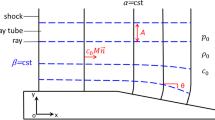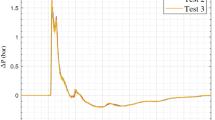Abstract
The direct numerical simulation of blast waves is a challenging task due to the wide range of spatial and temporal scales involved. Moreover, in a real environment (topography, urban area), the blast wave interacts with geometrical obstacles, resulting in reflection, diffraction, and wave recombination phenomena. The shape of the front becomes complex, which limits the efficiency of simple empirical methods. This work aims at contributing to the development of a fast running method for blast waves propagating in the presence of obstacles. This is achieved through an ad hoc extension of the simplified hyperbolic geometrical shock dynamics (GSD) model, which leads to a drastic reduction in the computational cost in comparison with the full Euler system. The new model, called geometrical blast dynamics, is able to take into account any kind of source and obstacle. It relies on a previous extension of GSD for diffraction over wedges to obtain consistent physical behavior, especially in the limit of low Mach numbers. The new model is fully described. Its numerical integration is straightforward. Results compare favorably with experiments, semiempirical models from the literature, and Eulerian simulations, over a wide range of configurations.


















Similar content being viewed by others
References
Nguyen-Din, M., Lardjane, N., Duchenne, C., Gainville, O.: Direct simulations of outdoor blast wave propagation from source to receiver. Shock Waves 27, 593–614 (2017). https://doi.org/10.1007/s00193-017-0711-2
Kinney, G., Graham, K.: Explosive Shocks in Air. Springer, Berlin (2013)
US Army Corps of Eng. Naval Facil. Eng. Command, A.F.C.E.S.A.: Unified Facilities Criteria (UFC) 3-340-02: Structures to resist the effect of accidental explosions (2008). https://www.wbdg.org/FFC/DOD/UFC/ARCHIVES/ufc_3_340_02.pdf. Accessed 05 Aug 2019
Eveillard, S., Lardjane, N., Vinçont, J., Sochet, I.: Towards a fast-running method for blast-wave mitigation by a prismatic blast wall. C. R. Méc. 341(8), 625–635 (2013). https://doi.org/10.1016/j.crme.2013.06.004
Silvestrini, M., Genova, B., Trujillo, F.L.: Energy concentration factor a simple concept for the prediction of blast propagation in partially confined geometries. J. Loss. Prev. Process. Ind. 22(4), 449–454 (2009). https://doi.org/10.1016/j.jlp.2009.02.018
Needham, C.: Blast wave propagation. In: Blast Waves, pp. 87–99. Springer (2010). https://doi.org/10.1007/978-3-319-65382-2
Boutillier, J., Ehrhardt, L., De Mezzo, S., Deck, C., Magnan, P., Naz, P., Willinger, R.: Evaluation of the existing triple point path models with new experimental data: proposal of an original empirical formulation. Shock Waves 28, 243–252 (2018). https://doi.org/10.1007/s00193-017-0743-7
Miller, P.: Towards the modelling of blast loads on structures. Master Thesis, University of Toronto (2004). http://www.vectoranalysisgroup.com/theses/Miller-MASc(2004).pdf. Accessed 05 Aug 2019
Lapébie, E.: Flash: fast lethality assessment for structures and humans. Colloque de restitution du projet ANR Democrite, Paris (2018). http://www.anr-democrite.fr/sites/mines-ales.fr/files/u178/3.2_explosions.pdf. Accessed 07 June 2020
Flood, I., Bewick, B., Dinan, R.: A new method for very fast simulation of blast wave propagation in complex built environments. Technical Report, DTIC document (2010). https://pdfs.semanticscholar.org/e3df/2abe910276e7f46c4e9a7b70b8337c2ff6f1.pdf. Accessed 05 Aug 2019
Whitham, G.: A new approach to problems of shock dynamics. Part I: two-dimensional problems. J. Fluid Mech. 2(2), 145–171 (1957). https://doi.org/10.1017/S002211205700004X
Whitham, G.: A new approach to problems of shock dynamics. Part II: three-dimensional problems. J. Fluid Mech. 5(3), 369–386 (1959). https://doi.org/10.1017/S002211205900026X
Whitham, G.: Shock dynamics. In: Linear and Nonlinear Waves, 3rd edn. Wiley (1999). https://doi.org/10.1002/9781118032954
Best, J.: A generalisation of the theory of Geometrical Shock Dynamics. Shock Waves 1(4), 251–273 (1991). https://doi.org/10.1007/BF01418882
Schwendeman, D., Whitham, G.: On converging shock waves. Proc. R. Soc. Lond. A Math. Phys. Eng. Sci. 413, 297–311 (1987). https://doi.org/10.1098/rspa.1987.0116
Schwendeman, D.: On converging shock waves of spherical and polyhedral form. J. Fluid Mech. 454, 365–386 (2002). https://doi.org/10.1017/S0022112001007170
Catherasoo, C., Sturtevant, B.: Shock dynamics in non-uniform media. J. Fluid Mech. 127, 539–561 (1983). https://doi.org/10.1017/S0022112083002876
Besset, C., Blanc, E.: Propagation of vertical shock waves in the atmosphere. J. Acoust. Soc. Am. 95(4), 1830–1839 (1994). https://doi.org/10.1121/1.408689
Skews, B.: The shape of a diffracting shock wave. J. Fluid Mech. 29(02), 297–304 (1967). https://doi.org/10.1017/S0022112067000825
Coulouvrat, F., Marchiano, R.: Nonlinear Fresnel diffraction of weak shock waves. J. Acoust. Soc. Am. 114(4), 1749–1757 (2003). https://doi.org/10.1121/1.1610454
Bazhenova, T., Gvozdeva, L., Zhilin, Y.: Change in the shape of the diffracting shock wave at a convex corner. Acta Astronaut. 6(3), 401–412 (1979). https://doi.org/10.1016/0094-5765(79)90107-3
Sharma, V., Radha, C.: On one-dimensional planar and nonplanar shock waves in a relaxing gas. Phys. Fluids 6(6), 2177–2190 (1994). https://doi.org/10.1063/1.868220
Sharma, V., Radha, C.: Three dimensional shock wave propagation in an ideal gas. Int. J. Non Linear Mech. 30(3), 305–322 (1995). https://doi.org/10.1016/0020-7462(95)00005-9
Pandey, M., Sharma, V.: Kinematics of a shock wave of arbitrary strength in a non-ideal gas. Q. Appl. Math. 67(3), 401–418 (2009). https://doi.org/10.1090/S0033-569X-09-01111-5
Ridoux, J., Lardjane, N., Monasse, L., Coulouvrat, F.: Comparison of Geometrical Shock Dynamics and kinematic models for shock wave propagation. Shock Waves 27(5), 1–16 (2017). https://doi.org/10.1007/s00193-017-0748-2
Oshima, K., Sugaya, K., Yamamoto, M., Totoki, T.: Diffraction of a plane shock wave around a corner. ISAS Rep. 30(2), 51–82 (1965)
Oshima, K.: Propagation of spacially non-uniform shock waves. ISAS Rep. 30(6), 195 (1965)
Ridoux, J., Lardjane, N., Monasse, L., Coulouvrat, F.: Beyond the limitation of Geometrical Shock Dynamics for diffraction over wedges. Shock Waves 29, 1–23 (2019). https://doi.org/10.1007/s00193-018-00885-w
Peace, J., Lu, F.: On the propagation of decaying planar shock and blast waves through non-uniform channels. Shock Waves 28, 1–15 (2018). https://doi.org/10.1007/s00193-018-0818-0
Courant, R., Friedrichs, K.: Supersonic Flow and Shock Waves, vol. 21. Springer, Berlin (1999)
Swisdak, M.M.J.: Simplified kingery airblast calculations. Minutes of the 26th DOD Explosives Safety Seminar (1994). http://www.dtic.mil/dtic/tr/fulltext/u2/a526744.pdf. Accessed 16 Jan 2017
Ben-Dor, G.: Oblique shock wave reflections. In: Handbook of Shock Waves, vol. 2, pp. 68–179. Academic Press (2000)
von Neumann, J.: John von Neumann collected work. In: Taub, A.H. (ed.) Oblique Reflections of Shocks Shock Waves Reflections, vol. 6, pp. 238–299. Pergamon Press, Oxford (1963)
Colella, P., Henderson, L.: The von Neumann paradox for the diffraction of weak shock waves. J. Fluid Mech. 213, 71–94 (1990). https://doi.org/10.1017/S0022112090002221
Skews, B., Ashworth, J.: The physical nature of weak shock wave reflection. J. Fluid Mech. 542, 105–114 (2005). https://doi.org/10.1017/S0022112005006543
Baskar, S., Coulouvrat, F., Marchiano, R.: Nonlinear reflection of grazing acoustic shock waves: unsteady transition from von Neumann to mach to Snell–Descartes reflections. J. Fluid Mech. 575, 27–55 (2007). https://doi.org/10.1017/S0022112006003752
Henshaw, W., Smyth, N., Schwendeman, D.: Numerical shock propagation using Geometrical Shock Dynamics. J. Fluid Mech. 171, 519–545 (1986). https://doi.org/10.1017/S0022112086001568
Taylor, G.: The formation of a blast wave by a very intense explosion. Theorical discussion. Proceedings of the Royal Society of London. Series A, Mathematical and Physical Sciences, pp. 159–174 (1950). https://doi.org/10.1098/rspa.1950.0049
Jourdren, H.: HERA: a hydrodynamic AMR platform for multi-physics simulations. In: Adaptive Mesh Refinement-Theory and Applications, pp. 283–294. Springer (2005). https://doi.org/10.1007/3-540-27039-6_19
Eveillard, S.: Propagation d’une onde de choc en présence d’une barrière de protection. PhD thesis, Université d’Orléans (2013). www.theses.fr/2013ORLE2026/document. Accessed 05 Aug 2019
Noumir, Y., Le Guilcher, A., Lardjane, N., Monneau, R., Sarrazin, A.: A fast-marching like algorithm for Geometrical Shock Dynamics. J. Comput. Phys. 284, 206–229 (2015). https://doi.org/10.1016/j.jcp.2014.12.019
Peton, N., Lardjane, N.: An immersed boundary method for geometrical shock dynamics. J. Comput. Phys. 417, (2020). https://doi.org/10.1016/j.jcp.2020.109573
Acknowledgements
Part of this work has been possible thanks to the LETMA collaboration: a contractual research laboratory between CEA, CNRS, École Centrale Lyon, C-Innov, and Sorbonne University.
Author information
Authors and Affiliations
Corresponding author
Additional information
Communicated by C. Needham.
Publisher's Note
Springer Nature remains neutral with regard to jurisdictional claims in published maps and institutional affiliations.
Appendix: Results for blast wave reflection over a concave corner
Appendix: Results for blast wave reflection over a concave corner
Numerical results for reflection of a spherical blast wave over a concave corner, as explained in Sect. 5.2, are summarized in Table 8. 2D axisymmetric Lagrangian simulations have been performed with \(\Delta s=0.005\) m. For \({\text {dist}}=1\) m and \(\theta _\mathrm {w}=90^\circ \), the shock–shock meets the axis of symmetry resulting in a second Mach stem which perturbs results at 5 m from the corner.
Rights and permissions
About this article
Cite this article
Ridoux, J., Lardjane, N., Monasse, L. et al. Extension of geometrical shock dynamics for blast wave propagation. Shock Waves 30, 563–583 (2020). https://doi.org/10.1007/s00193-020-00954-z
Received:
Revised:
Accepted:
Published:
Issue Date:
DOI: https://doi.org/10.1007/s00193-020-00954-z




